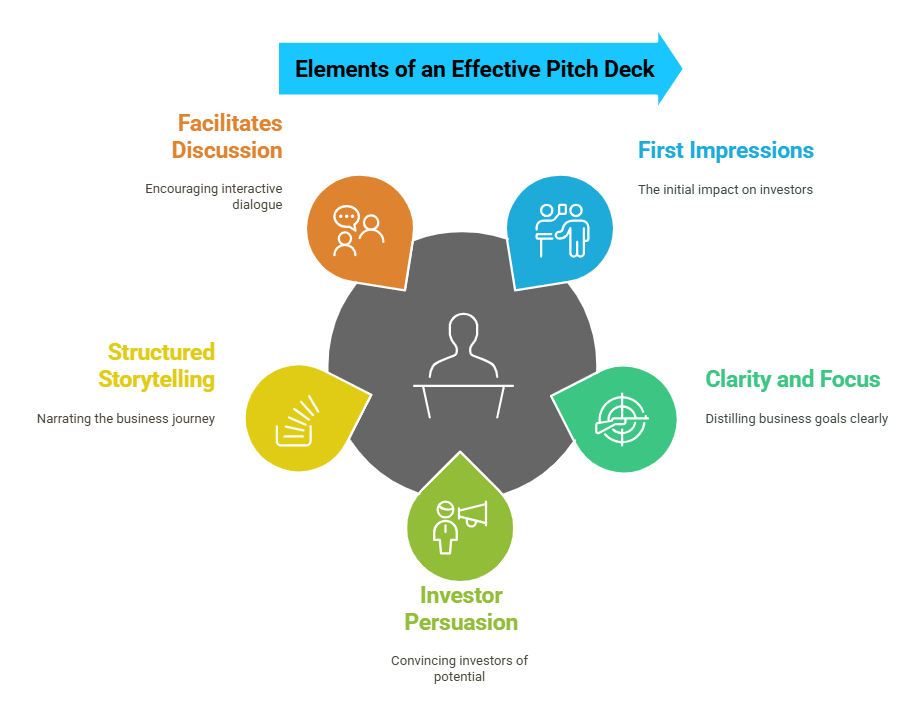Creating a compelling pitch deck is crucial for securing investment for your startup. A pitch deck serves as a visual presentation that highlights your business plan, showcasing your product, market opportunity, and team to potential investors. In this guide, we’ll walk you through how to make a pitch deck for investors that captivates and maximises your chances of securing funding.
What is a Pitch Deck?
A pitch deck is a concise, visual presentation that provides an overview of your business plan, product, and growth potential to potential investors. It is typically composed of 10-20 slides that cover essential aspects of your business, such as the problem you’re solving, your unique solution, the market opportunity, your business model, traction, and the team behind the project.
The purpose of a pitch deck is to grab the attention of investors, generate interest in your startup, and persuade them to take the next step, whether that’s a follow-up meeting, due diligence, or investment. It’s a key tool for startups to communicate their vision and convince investors of the potential return on investment.
Importance of a Pitch Deck For Investors

The pitch deck is vital for several reasons:-
1. First Impressions
The pitch deck is often the first point of contact between a startup and potential investors. A well-crafted pitch deck can make a strong first impression, setting the tone for future discussions.
2. Clarity and Focus
Creating a pitch deck forces you to distil your business plan into its most essential components. This helps you clarify your business goals and ensure that you can communicate your value proposition clearly and concisely.
3. Investor Persuasion
Investors are constantly bombarded with pitches, so your deck needs to stand out. A compelling pitch deck can effectively convey the excitement and potential of your startup, persuading investors to consider funding your venture.
4. Structured Storytelling
A pitch deck helps you tell your startup’s story in a structured way, leading investors through the problem, your solution, the market opportunity, and your business model. It guides the conversation, ensuring that all key points are covered.
5. Facilitates Discussion
A pitch deck is a conversation starter. It provides a visual aid during meetings, helping you explain your business more effectively. It also makes it easier for investors to ask questions and understand your vision.
Suggested Read:
The Process Of Creating A Pitch Deck
1. Start With A Strong Introduction
Your pitch deck should begin with a captivating introduction. This slide should include your company name, your tagline, and a brief statement that explains what your startup does. This is your first impression, so make it count by clearly articulating your value proposition.
2. Problem Statement
Investors are interested in the problems your product or service solves. Use this slide to define the problem in the market that your startup addresses. Make sure to explain the problem in simple terms and why it matters. A good strategy is to use data and statistics to back up your claims, making the problem feel urgent and significant.
3. Solution
After outlining the problem, introduce your solution. Describe how your product or service effectively addresses the problem. Visual elements like images, screenshots, or videos can be very effective here. Keep it clear and concise—investors should quickly understand how your solution stands out from existing alternatives.
4. Market Opportunity
This section should highlight the size of the market you’re targeting. Investors want to know that there’s a significant opportunity for growth. Use data to show the total addressable market (TAM) and serviceable obtainable market (SOM). You can also mention the market trends that make this the right time for your solution.
5. Business Model
Your business model slide should explain how you plan to make money. Describe your revenue streams, pricing strategy, and sales tactics. Be transparent about your monetization plan, and if you have any early traction, such as sales figures or user growth, this is a great place to showcase it.
6. Traction
Traction is a critical component of your pitch deck. Investors are more likely to fund a startup that has already shown signs of success. Include any key metrics that demonstrate your progress, such as user growth, revenue, partnerships, or customer testimonials. Visual aids like graphs and charts can be very persuasive here.
7. Marketing and Sales Strategy
Explain how you plan to attract and retain customers. This slide should cover your go-to-market strategy, including your marketing channels, sales process, and customer acquisition cost (CAC). Highlight any unique tactics or partnerships that give you a competitive advantage.
8. Competitive Analysis
Every investor knows there’s competition, so don’t ignore it. Instead, use this slide to highlight your competitive landscape. Include a competitive matrix that shows where your product or service stands in comparison to others. Clearly articulate your unique selling proposition (USP) and why customers would choose you over the competition.
9. Financial Projections
Provide a financial forecast for the next 3-5 years. Include projected revenue, expenses, and profitability. Be realistic but optimistic—investors want to see that you have a clear plan for achieving financial success. It’s also essential to be prepared to explain the assumptions behind your projections.
10. Team
Investors don’t just invest in ideas; they invest in people. Use this slide to introduce your core team members. Highlight their relevant experience, expertise, and the role they play in your startup. If you have any notable advisors or board members, include them here as well.
11. Use of Funds
Explain how you plan to use the funds you’re seeking. Be specific about the areas where the investment will go, such as product development, marketing, hiring, or expanding operations. This helps investors understand how their money will drive growth and value in your company.
12. Closing Slide
End your pitch deck with a powerful closing slide that reiterates your vision and the opportunity at hand. Include a call to action, such as scheduling a follow-up meeting or setting up a demo. Don’t forget to include your contact information.
By following this structure and tailoring each slide to your unique business, you can create a pitch deck that captures investor interest and helps you secure the funding you need.
Frequently Asked Questions Related To How To Make a Pitch Deck For Investors
How long should a pitch deck be?
What’s the most important slide in a pitch deck?
How detailed should financial projections be?
Can I include a product demo in my pitch deck?
Yes, a product demo can be a powerful addition to your pitch. It provides a tangible example of your product in action and can help investors better understand its value.
Should I mention competitors in my pitch deck?
Absolutely. Acknowledging competitors shows that you understand the market. Highlighting your competitive advantages will help investors see why you’re a better option.




